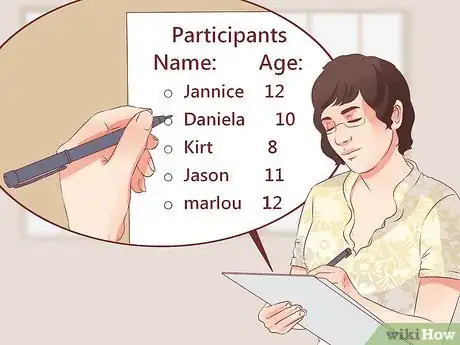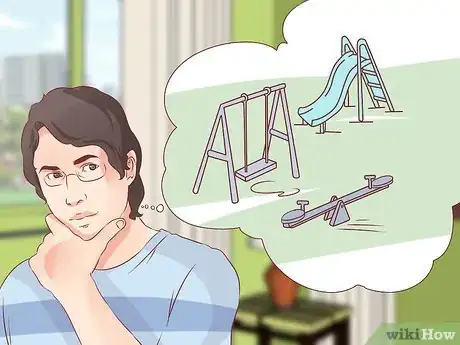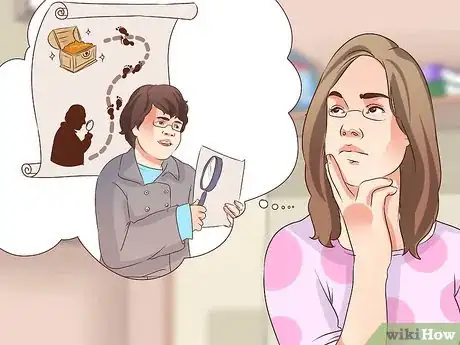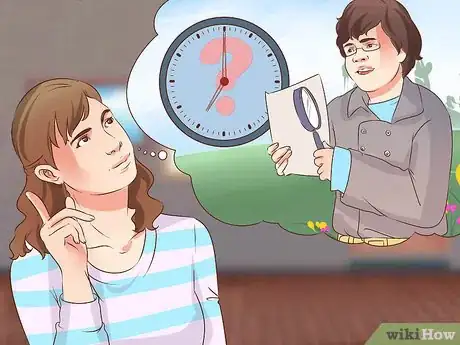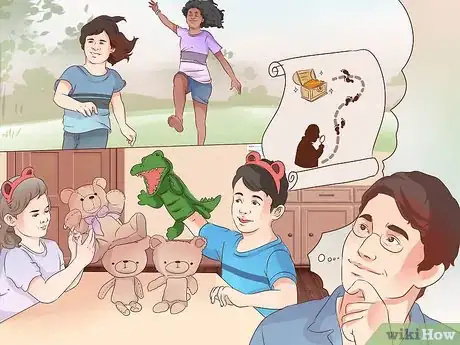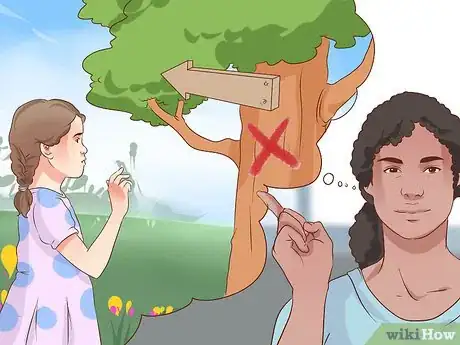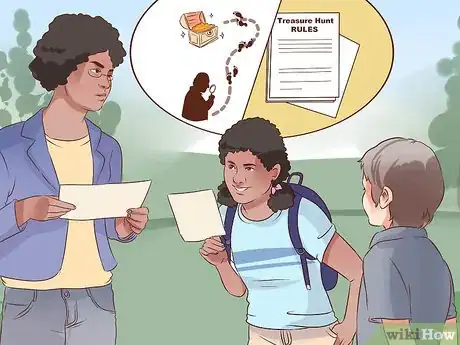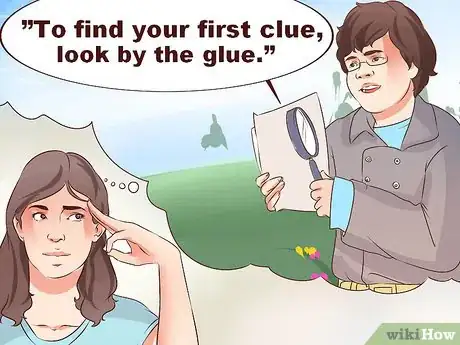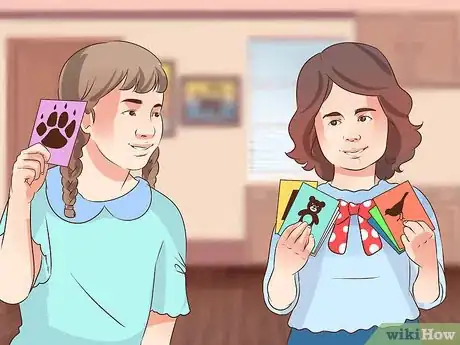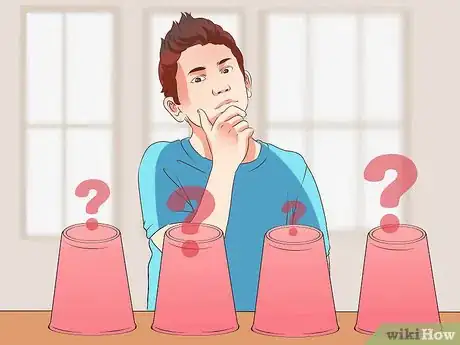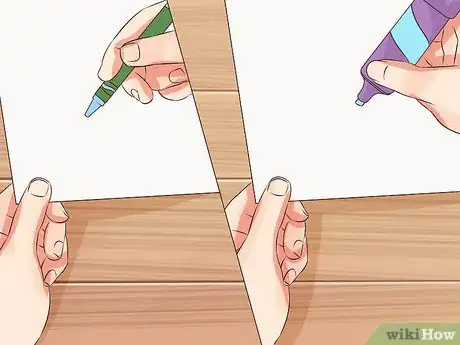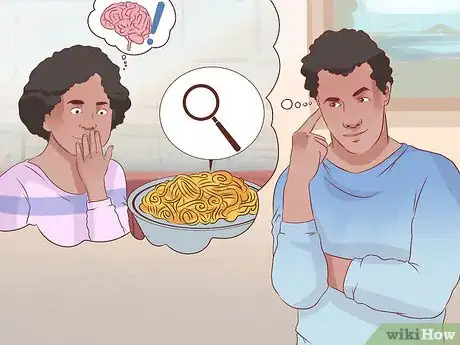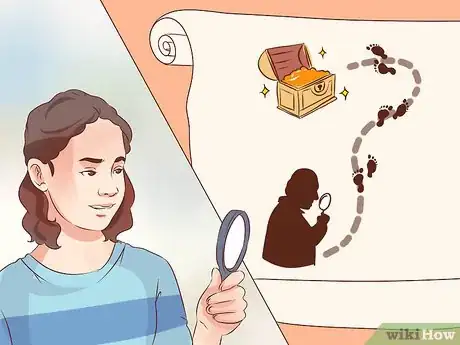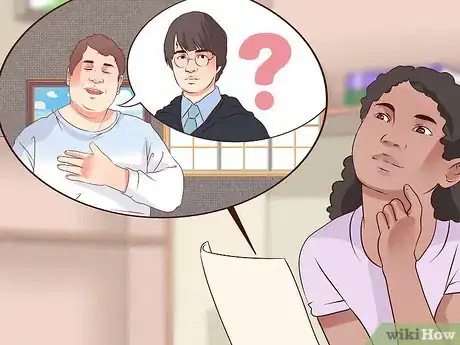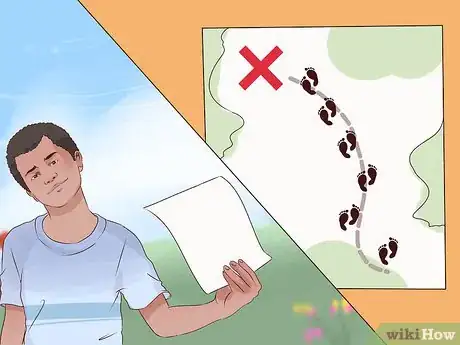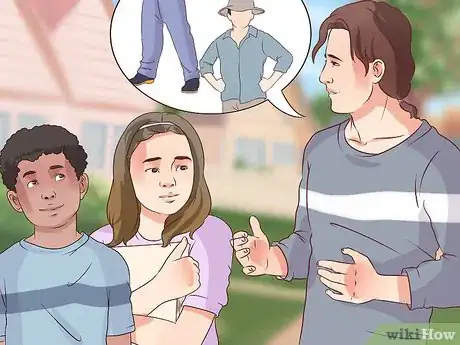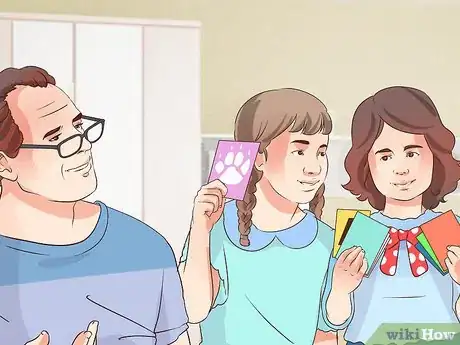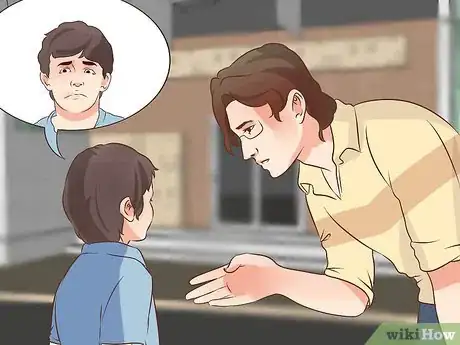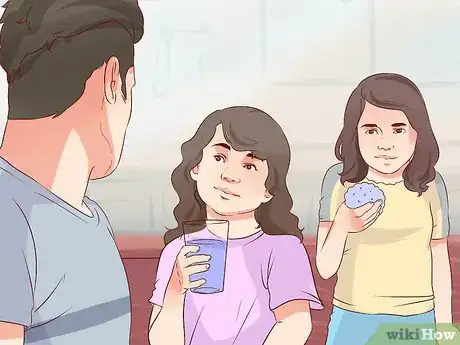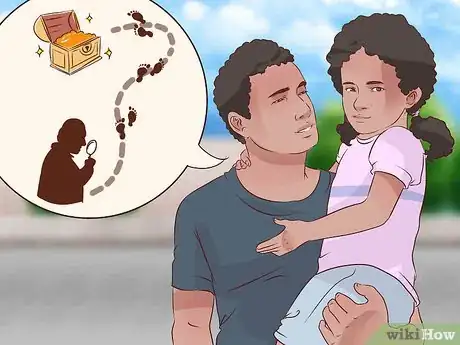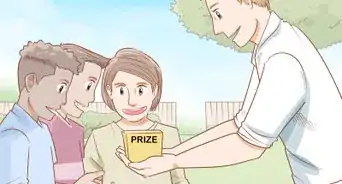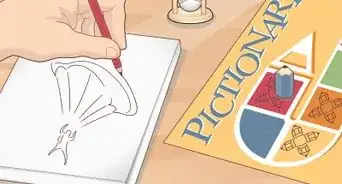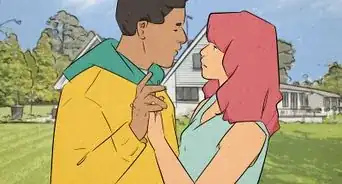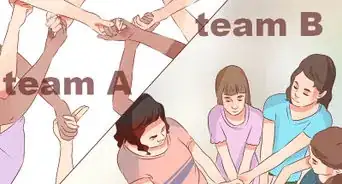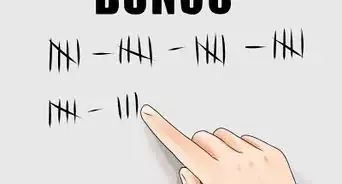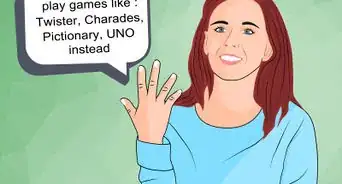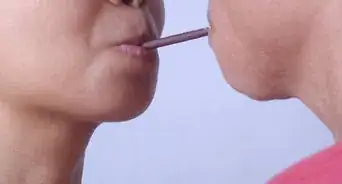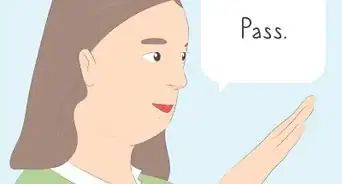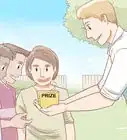This article was co-authored by wikiHow Staff. Our trained team of editors and researchers validate articles for accuracy and comprehensiveness. wikiHow's Content Management Team carefully monitors the work from our editorial staff to ensure that each article is backed by trusted research and meets our high quality standards.
There are 9 references cited in this article, which can be found at the bottom of the page.
This article has been viewed 954,661 times.
Learn more...
Whether it's too cold to play outside, a birthday party, or just an ordinary day, treasure hunts are a great and easy way to keep kids entertained. They offer a huge amount of everlasting fun and will improve their physical and intellectual development. Here are ideas on how to stage a treasure hunt for kids.
Steps
Preparing the Hunt
-
1Know your audience. Different kids will enjoy different types of clues. Usually, the biggest thing to think about is the difficulty of the hunt and tailor it to the right age. Some other considerations include:
- The age of the children; you have to ensure that the intellectual level is directly suited to the children participating.
- The amount of time the treasure hunt should take; younger children will become bored and irritated easily once they become bored.
- Whether or not any of the kids have food allergies, or want special treats.
-
2Choose a large, age-appropriate location. You want enough room to let the kids roam, but not enough to let them get lost. For younger kids, it may help to do the hunt as a group, or with adult "buddies," if you want to move around a wider area without getting confused or lost.
- For kids aged 2-4, have the treasure hunt inside a home familiar to them. This should be a small and supervised area.
- For kids aged 5-8, have it inside and outside of a home. Again, this needs to be supervised and if outside; separate from the public.
- For kids aged 9-12, have it at a location such as a school or park. This allows children to be more independent.
- For teens, have the hunt go all around a small town or farmer's market, or a big, wide-open field.
Advertisement -
3Decide on a format or theme for your treasure hunt. There’s a lot more to a treasure hunt than sending a bunch of kids off willy-nilly. The most amazing hunts usually have some common thread throughout them -- whether it is a theme, like The Hobbit, or a format, like a cooking hunt where each clue leads to an ingredient or recipe. Of course, there is also nothing wrong with a classic treasure hunt with clues and maps, either!
- Themes are good excuses to get everyone in costume, which can make it much more "realistic" for many children. For example, you could buy a pack of cheap eye patches and plastic swords and call it a hunt for pirate's booty.
- Do you want additional competition? Split the kids into two teams and have them race to the treasure. This will allow the children to improve their teamwork and better the communication skills. Make sure the kids are old and mature enough to handle this.
- Will they go after individual prizes, finding one at each clue, or do you want one big treasure waiting at the end?[1]
-
4Figure out how long you want the hunt to take. A good rule of thumb is that kids' patience will last through about twice as many clues as they are years old. Of course, even older kids may get a little tired after 26 clues. Anywhere between 5-15 is generally a good length, depending on how far apart the clues are from each other.
-
5Make a great treasure. The very last clue should lead to some sort of treasure or fun activity, rewarding everyone for finishing. Consider having a prize for the first person or team to get their as well, which will give some competition and urgency to the hunt..
- Decorate a box with pictures or construction paper, then fill it with goodies such as candy, coins, or toys.
- The treasure doesn't have to be a thing. You can set up a great meal, party area, or a game so that the kids arrive at a fun "secret grove."
- If the hunt is for smaller children, make sure there are some consolation prizes -- everyone should find or go home with something.
-
6When writing clues, work backwards from your final treasure. Once you know how it all ends, it's a lot easier to get people there. Each clue needs to lead to the next one, so figure out how to write a clue for your location, then hide it and repeat. Make sure, of course, that the last clue you write (and the first one the kids find) leads back to your starting point![2]
- Keep in mind that, though the first clue should be easy, they should increase in difficulty as the hunt goes on.
-
7Create a simple rule sheet. Pass out the rules at the beginning, and tell the kids to hold onto them if they are old enough to read and use it. If they are younger, share this with a few parents and chaperones and have them help enforce. This is a good place to put any special considerations too. Some things to consider include:
- Any places that are off-limits, or places that definitely have no clues
- Where to "turn in" clues, or what do to if you get stuck.
- Emergency contact numbers if anyone gets lost.
- Any time limit, or time to return to the house, even if you haven't "won" yet.[3]
Writing Different Types of Clues
-
1Make rhyming clues and riddles. The classic treasure hunt clue is a simple couplet, or rhyming lines. These can be easy, like "To find your first clue, look by the glue," or more opaque, such as "We travel together, one black and one white, you only meet us when the food isn't right" (by the salt and pepper).[4]
-
2Use pictures as clues. Draw or take photos of places they should investigate, figuring out where the actual location is. This is a great clue for younger kids, as it lets them get moving quickly. For the older crowd, you can up the ante by using vintage photos, satellite shots, or extreme close-ups for a more difficult hunt.[5]
-
3Incorporate games into some of the clues. For example, you could get three identical cups. Show the kids which cup you are hiding the clue under, then rapidly mix around the cups. The kids then have to guess which cup contains the clue. You can run egg races, small obstacle courses, or mini scavenger hunts as well, giving out the clue only once the game is complete.[6]
- This can be a good way to break up the middle of a hunt. Send them off on the first 4-5 clues, then go set up the game for the middle. After the game is over, they can get some food, water, and sunblock before hitting the next 4-5 clues.
-
4Use secret codes or invisible ink to make the clues a little more challenging. The simplest way to make invisible ink is to write something in white crayon, then have the kids go over it with highlighter. You can also make invisible ink, letting the kids figure out what to do with the "blank" clue on their own.[7]
- For kids of all ages, you could turn all of the lights off in a room so it is pitch black. Tell the kids to search for the clues with flashlights or by feeling around.
-
5Hide the clues in something "gross" or fun to explore. You might dunk the clues in a bowl of wet spaghetti "brains," forcing kids to go dig through. If you have some waterproof clues, you can put them in the bottom of the pool, giving kids a chance to jump in and swim (as long as they are supervised). Anything that makes them move and try out different things will be a blast.[8]
-
6Consider multi-part clues for older treasure hunters. For example, you can get custom-made puzzles cheaply online, which you can print with a clue. Then, at each smaller clue, you give out a puzzle piece, which build up to reveal one last clue or secret. Other ideas include:
- Giving out letters at each clue as part of a word scramble. The scrambled word is a password for another clue, or the answer to reveal the final treasure.
- Themed questions such as -- "the final answer is the one thing all the other clues have in common," or "the final clue comes from the first letter of all the other clues."
-
7Incorporate age-appropriate trivia, including popular characters and songs. This is especially fun if you have a themed treasure hunt. For example, you can ask "Where part of the house did Harry Potter have to live in as a kid?" which would send the children scrambling towards the closet for the next clue.
- Be sure to check with some kids beforehand, so that these clues are actually relevant or answerable![9]
-
8Use a map instead of classic "clues." This goes well with puzzles or multi-part clues. Write out a map, complete with illustrations and a few intentionally misleading parts (like an "accidentally" erased area). Then, at each location in the map, put a small prize or clue needed to open the final treasure, which prevents kids from racing straight to the end.
Running the Treasure Hunt
-
1Let the guests know the appropriate clothing for the hunt in advance. There is a big difference in getting a kid ready for an indoor hunt and an outdoor romp around the woods. Since only you know the clues and destinations on the hunt, be sure to let people know what to wear.
- Make sure you account for the weather as well, especially if you're outside. If it rains, can you still hold the hunt?[10]
-
2Decide on some fun way to present the first clue to the kids. The general idea is that the first clue leads in some way to another location, which has a clue leading to another location, and so on until they reach the treasure. But the first clue is usually delivered in a dramatic fashion, kicking things off with a bang:
- Presenting the clue in a cool box or wrapping, like a "wax sealed" envelope, a mini treasure box, rolled up in a bottle, etc.
- Presenting the clue to everyone at once, like with a banner, sign, or by announcing it out loud.
- Running a game or challenge, such as a pie eating contest, egg race, etc. When they finish the challenge, they get the first clue.[11]
-
3Be available for help and guidance if kids get stuck. While some challenge is good, and you don't have to help every time, kids will get quickly frustrated if they stall out on a clue. Have a couple of "back-up" clues in your brain to point kids in the right direction if you see them getting worried.
- Let the kids know at the beginning where to find you or other parents. Make sure you tell a few other chaperones where the clues are located so that they can help as well.[12]
-
4Provide water, snacks, and sunscreen, especially if it's going to be a long hunt. The last thing the kids will be thinking off as they dig for clues is hydration and sun block. So keep it on hand for them, or leave a few water bottles and block at some of the clues, allowing them to refuel on the go.
- A couple boxes of granola bars are a great, on-the-go snack. You can pass them out at the beginning or give them out halfway through.
-
5Buddy up any kids younger than 10, unless you're in a small enough area. Smaller children shouldn't be out on their own unless you can keep eyes on them at all times. The buddy system, where each kid has at least one partner to work with, will help them get through the hunt faster and much safer.
Community Q&A
-
QuestionWhat should I as the adult do when the kid finds the treasure?
 Community AnswerCongratulate him and move on. If the kids are on the younger end, give out participation awards.
Community AnswerCongratulate him and move on. If the kids are on the younger end, give out participation awards. -
QuestionWhat if each group has an age range from 2-12?
 Community AnswerMake sure every team has a mix of older kids and younger kids, and make sure the older kids know that they have to let the younger kids have a turn at leading, solving clues, etc.
Community AnswerMake sure every team has a mix of older kids and younger kids, and make sure the older kids know that they have to let the younger kids have a turn at leading, solving clues, etc. -
QuestionIs chocolate okay as a snack for my treasure hunt?
 Community AnswerYes, chocolate could be a great snack for a treasure hunt.
Community AnswerYes, chocolate could be a great snack for a treasure hunt.
Warnings
- Boredom happens, even during treasure hunts! Try not to be offended.⧼thumbs_response⧽
- If necessary, always consult the owner of the location in which you are doing the treasure hunt. Nobody likes to be unexpectedly stampeded by kids!⧼thumbs_response⧽
- Make sure to give all of the kids equal amounts of treasure! The last thing you want is a kid crying because he has less candy than his friend.⧼thumbs_response⧽
- Depending on where you are, kids will probably need to be supervised during a treasure hunt.
- Kids under six always need to have a teen or adult supervise.
- If you're somewhere other than a house, kids under ten need supervision at all times as well.
⧼thumbs_response⧽
Things You'll Need
- Paper
- A box for treasure
- A location appropriate for the treasure hunt
- Help from other adults (optional)
- Markers, crayons, decorative items, etc.
References
- ↑ https://www.persil.co.uk/activities-for-kids/plan-treasure-hunt-kids/
- ↑ http://handsonaswegrow.com/32-ways-kids-can-go-on-scavenger-hunts/
- ↑ https://www.persil.co.uk/activities-for-kids/plan-treasure-hunt-kids/
- ↑ http://www.parents.com/holiday/easter/printables/printables-treasure-hunt-and-scavenger-hunt-games/
- ↑ http://handsonaswegrow.com/32-ways-kids-can-go-on-scavenger-hunts/
- ↑ http://www.creativekidsathome.com/activities/activity_28.html
- ↑ http://www.creativekidsathome.com/activities/activity_28.html
- ↑ https://www.persil.co.uk/activities-for-kids/plan-treasure-hunt-kids/
- ↑ http://www.creativekidsathome.com/activities/activity_28.html
About This Article
If you want to make a treasure hunt for kids, choose a large, age-appropriate location, such as a house, a yard, or a park. Then, pick a theme for your treasure hunt based on the kids' interests, like pirates or fantasy, and pick a time limit between 5 and 15 minutes. Make the treasure fun and interesting by hiding clues and gifts throughout the location, and give each kid a map so they can find where the treasure is hidden. Be sure to include rules with the clues to make sure the game is fair! For tips on writing your clues and making sure everyone has fun, scroll down!
